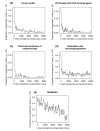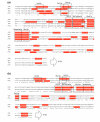Fast and systematic genome-wide discovery of conserved regulatory elements using a non-alignment based approach
- PMID: 15693947
- PMCID: PMC551538
- DOI: 10.1186/gb-2005-6-2-r18
Fast and systematic genome-wide discovery of conserved regulatory elements using a non-alignment based approach
Abstract
We describe a powerful new approach for discovering globally conserved regulatory elements between two genomes. The method is fast, simple and comprehensive, without requiring alignments. Its application to pairs of yeasts, worms, flies and mammals yields a large number of known and novel putative regulatory elements. Many of these are validated by independent biological observations, have spatial and/or orientation biases, are co-conserved with other elements and show surprising conservation across large phylogenetic distances.
Figures










Similar articles
-
Evolutionarily conserved elements in vertebrate, insect, worm, and yeast genomes.Genome Res. 2005 Aug;15(8):1034-50. doi: 10.1101/gr.3715005. Epub 2005 Jul 15. Genome Res. 2005. PMID: 16024819 Free PMC article.
-
Eukaryotic regulatory element conservation analysis and identification using comparative genomics.Genome Res. 2004 Mar;14(3):451-8. doi: 10.1101/gr.1327604. Genome Res. 2004. PMID: 14993210 Free PMC article.
-
Discovery of regulatory elements in vertebrates through comparative genomics.Nat Biotechnol. 2005 Oct;23(10):1249-56. doi: 10.1038/nbt1140. Nat Biotechnol. 2005. PMID: 16211068
-
Comparative genomics using fugu: a tool for the identification of conserved vertebrate cis-regulatory elements.Bioessays. 2005 Jan;27(1):100-7. doi: 10.1002/bies.20134. Bioessays. 2005. PMID: 15612032 Review.
-
Annotating non-coding regions of the genome.Nat Rev Genet. 2010 Aug;11(8):559-71. doi: 10.1038/nrg2814. Epub 2010 Jul 13. Nat Rev Genet. 2010. PMID: 20628352 Review.
Cited by
-
Identification of candidate regulatory sequences in mammalian 3' UTRs by statistical analysis of oligonucleotide distributions.BMC Bioinformatics. 2007 May 24;8:174. doi: 10.1186/1471-2105-8-174. BMC Bioinformatics. 2007. PMID: 17524134 Free PMC article.
-
Practical strategies for discovering regulatory DNA sequence motifs.PLoS Comput Biol. 2006 Apr;2(4):e36. doi: 10.1371/journal.pcbi.0020036. PLoS Comput Biol. 2006. PMID: 16683017 Free PMC article. No abstract available.
-
Systematic discovery of regulatory motifs in Fusarium graminearum by comparing four Fusarium genomes.BMC Genomics. 2010 Mar 26;11:208. doi: 10.1186/1471-2164-11-208. BMC Genomics. 2010. PMID: 20346147 Free PMC article.
-
H2A.Z-Mediated Genome-Wide Chromatin Specialization.Curr Genomics. 2007 Mar;8(1):59-66. doi: 10.2174/138920207780076965. Curr Genomics. 2007. PMID: 18645626 Free PMC article.
-
Revealing global regulatory perturbations across human cancers.Mol Cell. 2009 Dec 11;36(5):900-11. doi: 10.1016/j.molcel.2009.11.016. Mol Cell. 2009. PMID: 20005852 Free PMC article.
References
Publication types
MeSH terms
Grants and funding
LinkOut - more resources
Full Text Sources
Molecular Biology Databases

